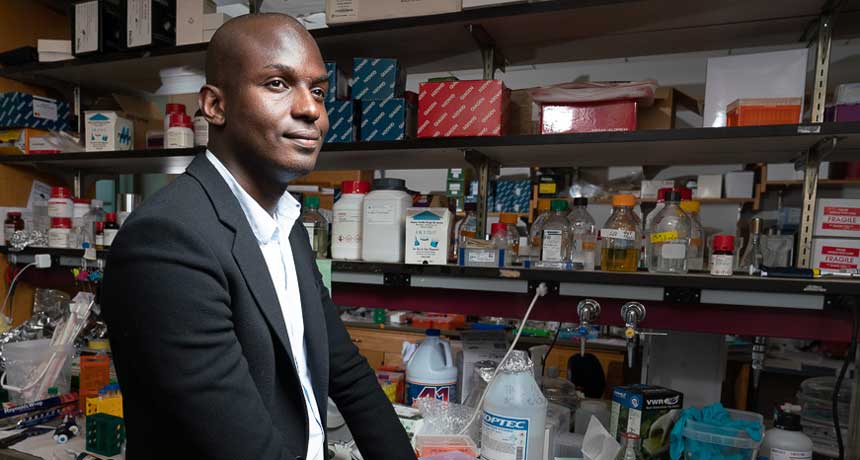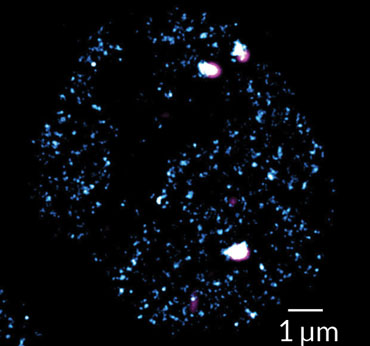
LIGHTS, CAMERA, ACTION Biophysicist Ibrahim Cissé makes movies of genes turning on and the proteins that make it happen.
Bryce Vickmark
Ibrahim Cissé, 35
Physics and biophysics
MIT
 Ibrahim Cissé expected to join his father’s law firm one day. “There were no scientists where I grew up in Niger,” says the MIT biophysicist. “I certainly didn’t know [science] was a profession one could do.”
Ibrahim Cissé expected to join his father’s law firm one day. “There were no scientists where I grew up in Niger,” says the MIT biophysicist. “I certainly didn’t know [science] was a profession one could do.”
But Cissé’s parents had a telling clue about their young son’s eventual career path: a door sign he made that read “Laboratoire de Cissé.”
Cissé learned about experiments in books, but his school in Niger’s capital city of Niamey didn’t have a lab. So, when he was about 10 or 11, he converted a storage room in his family’s house into an experimentation space. Behind that handmade sign, he tore apart electronics, rewired them, built new things with the parts and dreamed about becoming an astronaut on the space shuttle.
“People knew that anything that went into my lab was fair game for me to break apart,” he says.
At 17, Cissé moved to North Carolina to learn English. Later, on registration day at North Carolina Central University in Durham, a historically black college, a physics professor quizzed him about math and science and suggested Cissé major in physics. Then came the magic words: “We have a grant from NASA.” Recalling his cosmic childhood dreams, Cissé became a physics major.
Cissé, now 35, is “everything you could want in a young scientist,” says Anthony Hyman, a biologist at the Max Planck Institute of Molecular Cell Biology and Genetics in Dresden, Germany, who follows his work. “He’s dynamic, enthusiastic and interested.”
These days, Cissé, a newly minted American citizen, is breaking paradigms instead of electronics. He and colleagues are making movies using super-resolution microscopes to learn how genes are turned on. Researchers have spent decades studying this fundamental question.
Cissé thinks physics can help biologists better understand and predict the process of turning genes on, which involves copying genetic instructions from DNA into RNA. His work describes how and when proteins congregate to instigate this process, which keeps cells functioning properly throughout life.
Cissé was encouraged by physicist Carl Wieman, who won the Nobel Prize in physics in 2001 for his work on Bose-Einstein condensates, to apply for a fellowship to work at a big research university. As a result, Cissé spent a summer at Princeton University learning soft condensed matter physics, or study of the properties of liquids and other materials that can change shape, as it applied to randomly packing M&M’s into a jar. That work resulted in his first scientific paper, published in 2004 in Science.
During postdoctoral research, Cissé made what seems like a simple tweak to a single-cell microscopy technique, called PALM, that made his future discoveries possible, says Taekjip Ha, a biophysicist at Johns Hopkins University who was Cissé’s graduate mentor at the University of Illinois at Urbana-Champaign.
Cissé used PALM to examine RNA polymerase II in action. The enzyme is crucial for turning DNA instructions into the RNA messages that are read to produce proteins.
“He didn’t just use PALM to obtain pretty images,” Ha says. Cissé added “a time dimension.” Rather than taking stationary snapshots, Cissé essentially made movies that showed that RNA polymerase II forms clusters that fall apart once their job is done. The discovery was published in 2013 in Science.
“That finding was pretty provocative,” Ha says. Until then, researchers had thought that RNA polymerases formed stable factories that would park near a gene’s starting point and idle, waiting for other proteins to give them a push to turn the gene on.
A few years later, in 2016, Cissé and colleagues reported in eLife that the amount of time an RNA polymerase cluster stays together determines how many RNA messages are produced from a gene, a measure of how active the gene is.
In his latest studies, published in the July 27 Science (SN: 7/21/18, p. 14), Cissé and colleagues present evidence that proteins involved in turning on genes rapidly coalesce into concentrated droplets just before the process of copying DNA into RNA begins. Like water molecules condensing into a raindrop and then evaporating, proteins can quickly form these droplets and then disperse.
Individual proteins spend only seconds in the condensates, but collectively the molecules turn on genes. And bubbles of condensed proteins may interact with other bubbles, sometimes several, to turn on multiple genes at once.
The idea is controversial. Some researchers argue that this condensation process isn’t necessary to start gene activity.
To Cissé, knowing about these “bubbles” means researchers can draw on the physics of condensation — such as knowledge about cloud formation, rain and snow — to understand how gene-activating proteins behave and predict what will happen next.







